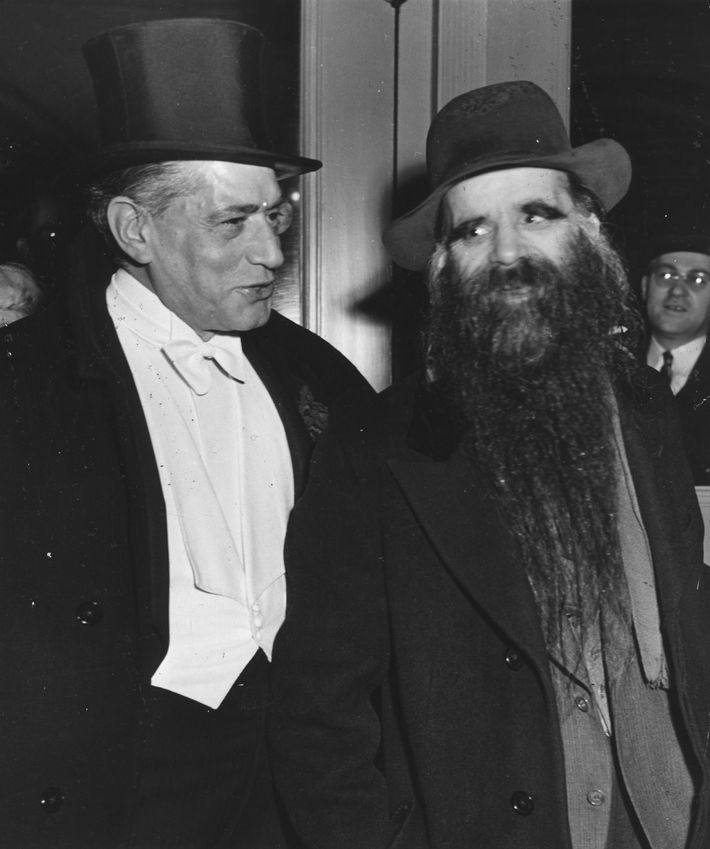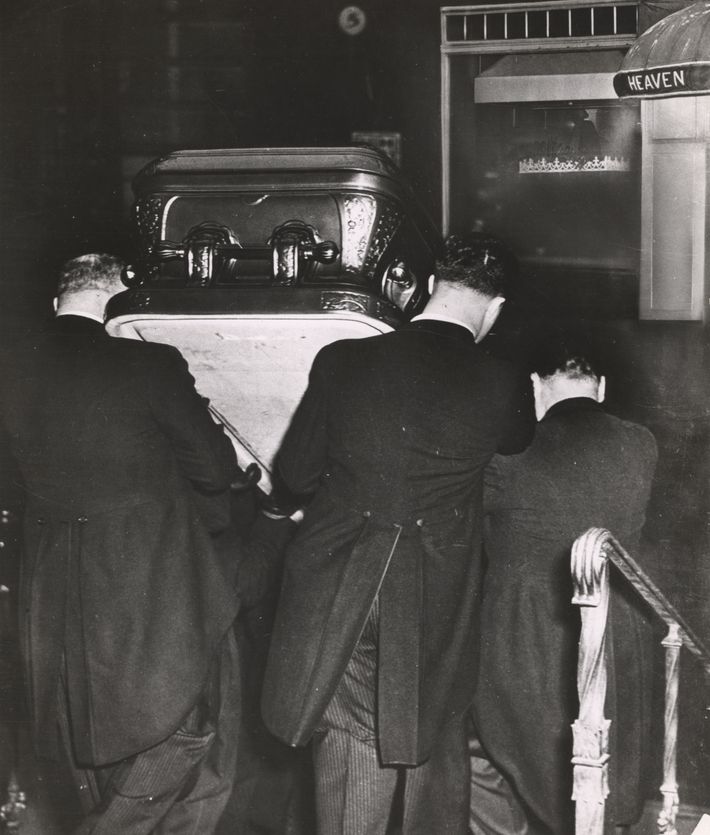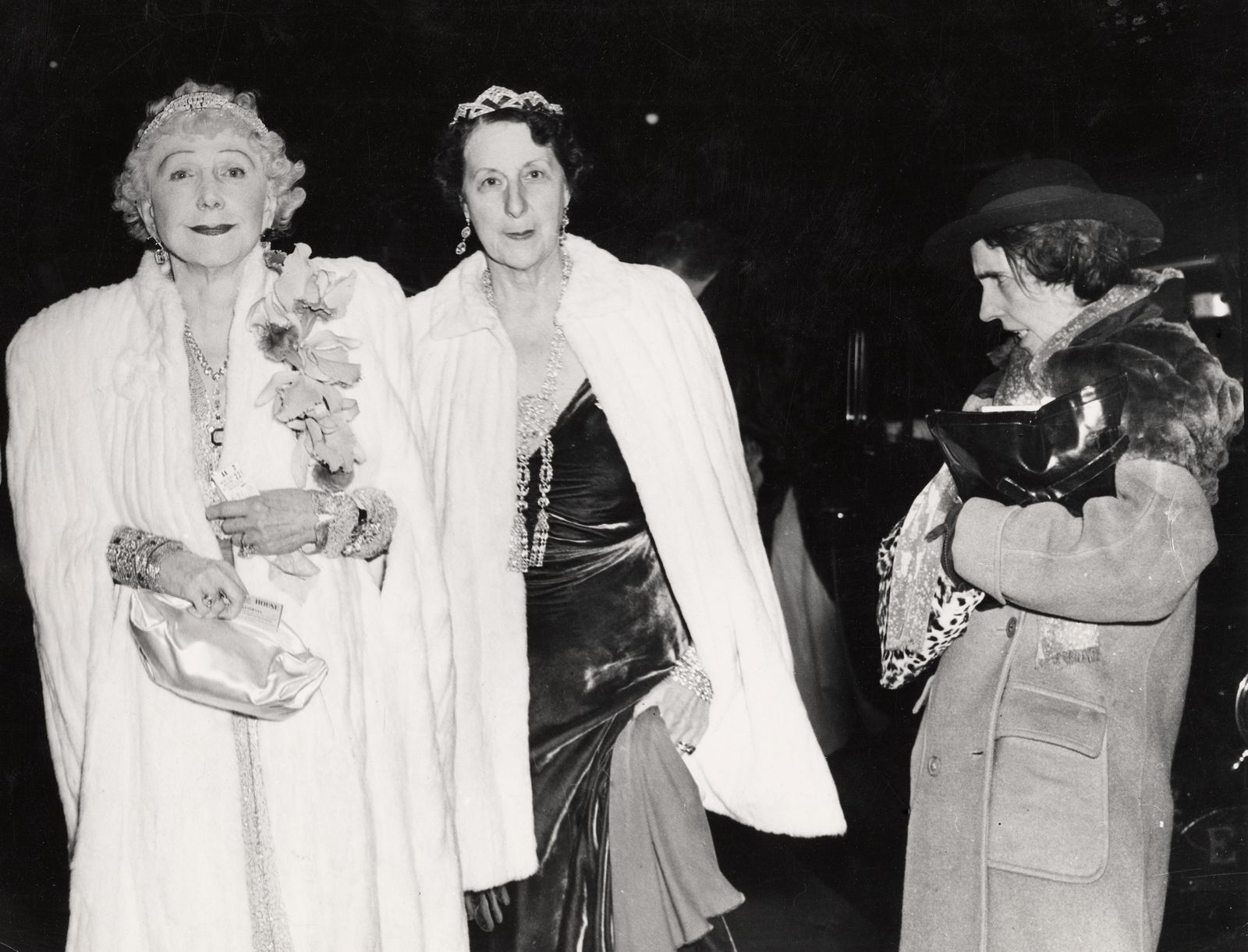We were thrilled to learn that this year’s National Book Critics Circle award for Biography went to New York editor Christopher Bonanos for his 2018 work Flash: The Making of Weegee the Famous. To celebrate, we’re republishing an excerpt that ran last year.
It was November 22, 1943, and Arthur Fellig, known as Weegee, was ready for the night shift. He had spent the previous few years building his reputation as the most prominent newspaper photographer in New York. After years of freelancing, he had, in 1940, made a loose first-look deal with PM, a new lefty tabloid aimed at the intelligentsia. Although he was best known for covering nighttime mayhem — murders, fires, car crashes — he could also do tabloid poetry and little urban mini-plays, and on this evening he was covering the 60th-anniversary opening night at the Metropolitan Opera House.
The previous fall, in 1942, he’d happened upon a great scene just outside the doors of the Met. (This was at the timeworn, genteel old opera house on 39th Street, long before the move to Lincoln Center.) It was a distinctly New York interaction, as a box-seat operagoer in white tie and tails paused next to a shabby standing-room-only patron with a foot-long beard. The well-dressed man turned out to be a British diplomat with the irresistible name of Bertram Cecil Eskell. “How are you, my good fellow?” Eskell had asked the other music lover, whose name went unrecorded. Weegee got a lot of mileage out of juxtapositions like this one, and PM did, too, running the photo at a full page, headlining it WEEGEE BRINGS BACK A “DIFFERENT” PICTURE OF OPERA’S OPENING NIGHT. Now, a year later, Weegee was faced with the prospect of one-upping himself.
Of course, he could not count on seeing a near-homeless figure at the stuffiest society event of the year, but Weegee knew how to take care of that.
Late in the afternoon, he and his assistant Louis Liotta headed to Sammy’s Bowery Follies, a popular saloon he frequented at 267 Bowery. (It’s still a bar, although the current leaseholder, a fancy brewpub, recently shut down.) There, they knew, they could get help from a female pal of Weegee’s. Her name is lost to history, but the photojournalist Sam Vandivert later said she was someone Weegee was dating. Whoever she was, Weegee and Liotta poured cheap wine into her, and at around dusk they got her into Weegee’s Chevy and headed up to 39th Street.
On the opening-night program was Mussorgsky’s Boris Godunov, chosen to celebrate American-Soviet cooperation on the European fronts. It was not quite two years after Pearl Harbor, and this was supposed to be an austere wartime evening, but you had to squint to see the cutbacks. The fall weather was just cool enough that plenty of mink had come out of storage. (“There was the same old smell of camphor hovering over the fancy furs,” wrote one reporter.) Still, there were fewer limousines than usual, owing to gasoline and tire shortages, and quite a few people in full evening dress had made their way there by public transportation. The Times fashion writer noted that “one matron dazzled the crowd surrounding the doors with her array of diamond bracelets from wrist to elbow. With emerald earrings and a diamond and emerald necklace, her bugle-beaded white chiffon provided a perfect setting.”
That could only have been Marie Muller Kavanaugh, customarily referred to in print as Mrs. George Washington Kavanaugh. Unlike many Social Register folks, she was not Old New York; she had grown up well-off but not rich in Virginia. She married into money not once but twice, first to a brewery heir, then to Mr. Kavanaugh, a textile magnate. And she loved everything about being rich: the living quarters (at one point she bought the townhouse next to hers, to ensure that it didn’t fall into the wrong hands), the fashion (she wore orchids to every big event), even the appearances in the press. She was, according to her great-granddaughter Alexandra Warner Nash, “the original person who was famous for being famous.” When her picture appeared on the society pages, she would send the photographer a bottle of Champagne if she felt he’d made her look good. Her friends occasionally referred to her as “Tiffany’s front window.” The diamond earrings she wore on this night weighed 20 carats each.
Weegee probably didn’t know her name. (“I didn’t know Society,” he once joked. “I’d never arrested them before.”) But he didn’t have to, given that she presented herself as a giant pouf of snowy pelts and precious stones. She was literally a sparkly object, clearly worth photographing, and as she arrived that night, a bit before 8 p.m., he was ready.

The standing-room-only line, on which people had been waiting since 4:30 a.m., snaked down 39th Street. Weegee’s competitors, the rest of the newspaper photographers, making red-carpet pictures, offered their customary ribbing — perhaps a little more barbed than usual. A reporter brushed him off when Weegee asked who one of the socialites was, responding that he should find out for himself or “go back to your corpses.” Weegee’s response, he explained later, was: “Being a nonconformist, I said to myself, Fuck that nonsense.” He went back out into the chill.
Anyway, he had a scene to set. His downtown female friend, unsteady from the wine, tottered outside the entrance, Liotta propping her up near the curb. Weegee stood a few steps away on the sidewalk, his camera set up for a 15-foot shot. Mrs. Kavanaugh (no subway for her) exited her chauffeured car. She was with her friend Elizabeth Wharton Drexel. A Philadelphian from the Drexel banking family, she’d outlived two husbands and was now on her third, an Irish peer named John Beresford, Fifth Baron Decies. That marriage had made her Lady Decies (pronounced DEE-shees), and she lived in Paris most of the time now. She was the sort of person who, when she’d disembarked at the New York piers one day in 1940, expressed dismay to a newspaper reporter that she hadn’t been able to buy the fur coat she wanted in Paris because Hermann Goering had snapped it up for his wife.
From his place on the sidewalk, Weegee signaled Liotta, who released the disheveled woman and gave her a little nudge into the frame. Judging by the photograph, she is reeling, barely able to stand. If there was one thing Weegee knew from being in a scrum of press photographers, it was how to make a few shots very quickly, swapping in sheets of film and flashbulbs as fast as he could. Flash: He caught Mrs. Kavanaugh and Lady Decies as the third woman observed them. Flash, again, a moment later, as the two ladies turned, passed him, and stepped into the lobby, facing half a dozen other photographers with the same tight smiles. Much later, Liotta told the journalist Joyce Wadler that there were three or four bulbs set off, almost too fast for him to parse. That was it. No different from shooting outside police headquarters any day of the week.
Although Weegee had staged the sidewalk encounter, he couldn’t have known quite how perfectly the tableau would square up on film. The two ladies in fur are almost pure white, nearly blown out by his flash. Mrs. Kavanaugh’s smile is taut and paper-thin, the essence of fatuousness; Lady Decies looks quizzical, perhaps a little sour, her mouth pursed. They both face the camera square on. The drunken woman, by contrast, is caught in perfect 90-degree profile, giving her features a sharpness against the nearly black background. Because her clothes are darker, she doesn’t pick up the flash as the bejeweled ladies do. Her coat reads dishwater gray, her hair lank, her scowl dark, her eyes rolling. She seems shorter, too. Weegee wanted a contrast; he got more than he could have asked for.
Whenever Weegee told the story of that night, he left out the wine, the setup, the offstage assistant, and the planted observer. He’d just thought he was making a picture of Mrs. Kavanaugh and Lady Decies, he always said, claiming that he “could almost smell the smugness.” He never saw the disheveled woman, he said, until he was in the darkroom. A few years later, writing about it, he flatly stated, “This is an unposed shot”; in another account he wrote “that was really honest.” None of these statements is true. But he certainly may have been surprised at just how entertaining a scene he’d built. The next morning, he brought the photo to PM.
They didn’t want it. In retrospect, it seems impossible that the talented photo editors there wouldn’t recognize one of the great photographs of the 20th century when it landed on their desks. But PM was steeped in war coverage just then and aspired to an occasionally pointy-headed good citizenship. After months of blackouts and scrap drives, the editors flinched at the sight of Mrs. Kavanaugh’s diamonds. Rather than seeing a chance to make a statement at her expense, they simply rejected the photo. (It was a move that Weegee, using a favorite word, described to an acquaintance as “dopey.”)
Life’s editors liked Weegee’s photograph more than PM’s had, and ran it the next week. Even there, though, it was buried: It ran at perhaps an eighth of a page in size, in a row of pictures along the bottom of a spread, with a dry-wit text block reading, “The fashionable people were laden with jewels. Most bejeweled were Mrs. George W. Kavanaugh and Lady Decies whose entry was viewed with distaste by spectator.”
Although this clearly was a great picture among many that Weegee made, it was not deemed exceptional right away. That is probably inevitable: There’s no way for an artist to predict which of his or her works becomes the one. But it did have one thing that is necessary in popular art: It could arrest the eye and evoke a reaction.
One of the eyes it caught and held belonged to Nancy Newhall, who in early 1944 was selecting photographs for another exhibition at the Museum of Modern Art. It was an extravaganza called “Art in Progress,” marking the Modern’s 15th anniversary. For the first time, every department in the museum would be showing simultaneously, blurring boundaries among media. Photography appeared on the first floor. Given the tiny size of the American art-photography community just then, the show could include a little from almost everybody, and it did: 15 prints by Ansel Adams, three by Berenice Abbott, handfuls by Helen Levitt, Edward Weston, Alfred Stieglitz, and many others. Weegee himself had five prints in the exhibition: two shootings, one fire, one circus performer, and the one that MoMA not quite correctly called “Opening Night at the Opera, N.Y.C. 1944.”
The show was up for four months, starting in May. Very quickly, it became obvious that something magical was happening in front of that Weegee photograph. People laughed, pointed, reacted. A week into the run, on June 2, PM’s editors tacitly acknowledged their blown call the previous November. This time, they ran the photo at large size, saying:
The big picture at lower right is the center of attraction in Weegee’s section of the Art in Progress photo exhibition now on view at the Museum of Modern Art. It shows Mrs. George Washington Kavanaugh and Lady Decies outside the Metropolitan Opera House — and the eloquent facial reaction of another woman. The other pictures on this page were snapped by Weegee as visitors to the photo exhibition looked at his pictures … The opera shot got the most laughs, Weegee reports.
It surely had, and Weegee’s voyeurdom had gone into a dizzying, recursive closed loop: He was photographing the observers who were looking at his photograph of a woman he’d posed as an observer, who was looking at a pair of dowagers who had been, in turn, looking directly at him. In the painting galleries at MoMA, visitors could see work by the Cubists that aimed to represent multiple points of view in one flat plane. Down on the first floor, it was happening in real time, using not the traditional tools of fine art but a Speed Graphic wielded on deadline.
Weegee called it the photograph that changed his life. A decade later, he claimed that he’d sold $10,000 worth of prints and was still getting requests for it. “With this picture,” he said, “I matured as a photographer and human being.”

Mrs. Kavanaugh, for her part, seems not to have minded. She didn’t stop posing at the opera, and Weegee and she chatted amiably at the next year’s opening. She kept on her flibbertigibbet ways for the rest of her very long life and, if anything, grew more famous for being famous. Life photographed her at home; when she lost a $5,000 bracelet a couple of years later at the Met, the search and recovery made the magazine, too. Weegee later said that she’d told him she found the photograph “too divine.” Today, there is, according to her great-granddaughter, “an enormous amount of family lore about that picture.” Warner herself was once in an English class where students were assigned to write about their reactions to a photograph, and you can guess which one the teacher unknowingly chose.
Even more extraordinary was the story that Mrs. Kavanaugh’s grandson Charles Warner told. He’d been in the Army in early 1944, fighting at Anzio, when a blizzard of enemy propaganda leaflets was dropped by plane over his squad. One of them read YANKEE — YOU DIE FOR THIS? and displayed that picture. (Warner did not reveal to his fellow GIs at that moment that the photo was of his own grandmother.) It sounds like a suspiciously great coincidence, and one of Warner’s old friends later offered that the leaflet had merely been picked up by a friend in Germany rather than fluttered down upon Warner’s own head. (Even that may be a stretching of the truth: No such flyer has ever surfaced.) Still, it’s only appropriate that a photo that was set up to look authentic inspired a questionably true war story that was too great not to tell.
As for Lady Decies, she buried her baron husband just weeks after that November evening, and she herself died the following June. Weegee found himself wishing to memorialize her in some way, and went to the funeral at St. Patrick’s Cathedral. He sat toward the back, looking for his moment. As the casket was brought down to the side exit of St. Patrick’s, he followed, watching. Then, as the pallbearers — he believed them to be paid, rather than friends or family — began making their way down the steps, a quintessential Weegee moment presented itself. Across 51st Street, there was a burger joint, its awning reading HAMBURG HEAVEN. A little careful positioning, and he had it: Lady Decies, at her final moment on Earth, pointed directly toward the word HEAVEN. On the prints he made, he retouched the awning to sharpen up the letters. One more darkroom tweak to throw reality into extra-high relief.
*Adapted from Flash: The Making of Weegee The Famous (Henry Holt; June 5). © 2018 by Christopher Bonanos. This article appears in the May 28, 2018, issue of New York Magazine. Subscribe Now!

